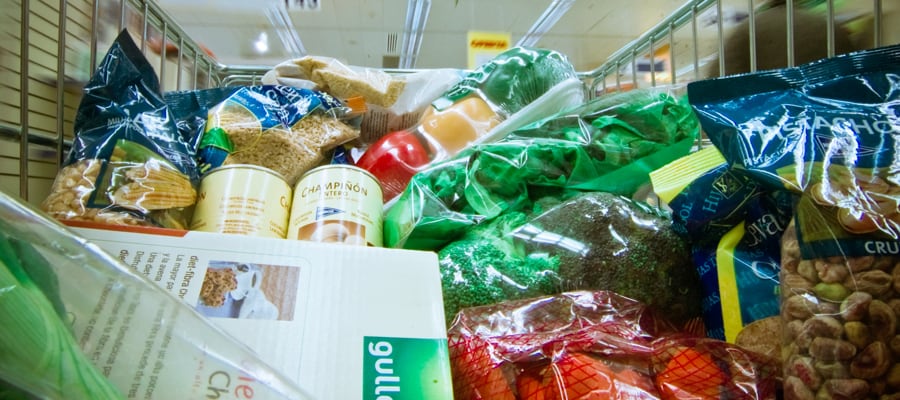The Economist is known for its deep analysis and heavy topics, but I found this article about supermarkets and the science of shopping. The first time I heard about supermarket psychology was when someone explained to me that the most appealing products were always shown at eye level. When the product is placed at eye level, you are more prone to picking it up and subsequently buying it. That’s only the beginning.
If there’s one lesson to be learned after reading this article, it’s that supermarkets are one big maze and we’re the rats running through them.
How Supermarket Psychology Works
The article is based out of Basingstoke, England but you’ll find that the description of the Sainsbury’s store layout is probably not unlike your local grocery store’s layout. My local Giant grocery store and ShopRite are laid out in the same manner. Our “decompression zone” holds the store circular and hand scanners. Our “chill zone” also has books and magazines and is set up right next to the pharmacy, presumably to keep you occupied if you’re waiting for your prescription.
Then we have fruits and vegetables, just like Sainsbury. Many of the staples, like meats and dairy, are located in the back after you walk through the aisles.
Traditionally retailers measure “footfall”, as the number of people entering a store is known, but those numbers say nothing about where people go and how long they spend there. But nowadays, a ubiquitous piece of technology can fill the gap: the mobile phone. Path Intelligence, a British company working with the Massachusetts Institute of Technology, tracked people’s phones at Gunwharf Quays, a large retail and leisure centre in Portsmouth—not by monitoring calls, but by plotting the positions of handsets as they transmit automatically to cellular networks. It found that when dwell time rose 1% sales rose 1.3%.
Sneaky and creepy stuff huh?
Now that you’ve become aware of the psychology behind supermarkets, let’s get down to the nitty-gritty with some tips that will help you win the war against those sneaky behavioral scientists and their mind games!
Supermarket Tricks
Here are a few tips I’ve learned when scouring the internet and my own mind. These are tips designed to save you money and time when you’re at the supermarket.
- Make a list: Unless my wife and I are in the mood to wander around the supermarket (only because it’s freezing outside), we make a list based on the sales so we can get in and out as quickly as possible. By making a list and sticking to it, we save ourselves tons of time wandering. We also can save money by using sales circulars to plan our week’s meals based on the products on sale.
- Don’t go when you’re hungry: This one is a common suggestion because it’s pretty obvious. When you’re hungry, everything looks good. Your desire to eat healthy goes out the window as you reach for a prepared meal that can be consumed after a two minute trip inside the microwave merry-go-round.
- Skip prepared foods: You can save a ton of money just by butchering the chicken yourself. This rule holds true for basically everything else. Do you want some pork chops? Consider buying an entire pork loin and cutting it yourself.
- Make your own prepared foods: Nothing stops you from getting the raw ingredients and making your own microwavable meals!
- Be brand agnostic: If all things are equal, go with what’s cheaper. Generic products are usually as good as the brand name products. Also, a sale on a brand named product doesn’t necessarily mean it’s cheaper than the generic version.
- Read these 13 things your grocer won’t tell you: I’m a fan of these types of articles so check our Reader’s Digests 13 things your grocer won’t tell you (#2 – go ahead and reach back for the fresh milk and #1 – shop at dinner time to save time).
Seven Items to Skip at the Supermarket
This is a list of seven items as well as reasons why you should skip on your trip to the grocery store. You’ll notice a theme here too, a lot of it has to do with products that have added labor in them. Bagged salads, spice mixes, tomato sauce. You can make many of these things yourself with a little extra work, work that can be a lot of fun!
- Bagged salad: Convenient, but costs almost three times as much. Kits are even worse (and the dressing is usually horrible for you in terms of calories).
- Energy or protein bars: They’ve replaced candy bars as the impulse buy of choice at checkout, you can buy these much cheaper online.
- Spice mixes: A lot have salt as the first ingredient and you probably have most of the other spices in your cupboard already.
- Bottled water: You’re overpaying for what you can get out of the tap, it’s one of the many items made more expensive by marketing.
- Boxed rice entree or side-dish mixes: It’s rice with a few other extras and you’re paying $3-4 a box for it, way too much.
- Pre-formed meat patties: Buy the meat yourself and make your own patties, the premium you pay for them forming them is not worth it. By forming them yourself, you can add your own spices and ingredients to make a tastier burger.
- Tomato-based pasta sauces: Buy canned tomatoes for $1 and add in your own ingredients instead of paying $2-$6 for a jar of their stuff. Here are a few homemade tomato sauce recipes you can use.
Do you have any tips for the supermarket?
